When the Dodge Coronet reappeared for the 1965 model year, it did so utilizing the company’s intermediate B-Body platform. The company offered a vast selection of engines, but one of the more desirable was the 426ci Max Wedge V8. For those with a passion for Mopar performance models, that may make this 1965 Coronet 500 hard to resist. Its engine bay houses its original Max Wedge, and the lack of accident damage or prior restoration work means it is a genuine survivor. The seller admits that it isn’t a real barn find, but that it has laid idle for more than a decade. The time seems right for this classic to find a new home, so the owner has listed it for sale here on eBay. The Cornet is located in Hemet, California, and comes with a BIN of $20,000. I have to say a huge thank you to Barn Finder T.J. for spotting this muscle classic for us.
One look at the baked paint gracing this Coronet’s panels tells a significant part of its story. The appearance is generally the result of exposure to harsh UV rays in a dry environment, which is the case with this classic. Before finding its way to California, it spent the balance of its life in the drier climes of Arizona. The blazing sun may have wrought havoc on its Code B Black paint, but it has preserved the steel beneath in the manner we generally expect of cars from that location. The seller states that the Coronet has never received any form of restoration, making its paint and panels original. The panels generally look pretty straight, but the best news for potential buyers is that this beauty remains rust-free. There’s the usual accumulation of dry surface corrosion that we might expect, but the dreaded tin worm hasn’t sunk its teeth into this classic. That makes it ideal for a DIY restoration because the project will involve no welding or cutting in returning the vehicle to its former glory. Given the overall originality of this gem, the buyer may elect a rotisserie restoration. That would allow them to effectively treat the corrosion, providing the opportunity for the car to remain rock-solid for many decades. Otherwise, the trim looks restorable, and the glass is fine for a survivor-grade car. The Magnum 500 wheels are a later addition, but the seller includes the factory spinner hubcaps in the sale.
The remarkably well-preserved steel and originality of this 1965 Coronet serve as an entree for what we find when lifting the hood. Dodge offered a vast selection of engines for buyers in 1965, but one of the most desirable is the 426ci Max Wedge V8. Capable of churning out 365hp, it is a motor that has attained legend status. This Coronet features a Max Wedge, a three-speed TorqueFlite transmission, and power steering. If the original owner had aimed this ground-bound jet down a ¼ mile, the journey would have taken a mere 14.8 seconds before the car wound its way to 118mph. It may be hard to believe that the news could get better with this classic, but I think you’ll agree it does. The seller indicates this is a numbers-matching survivor, which will have a significant positive impact on its potential value. It has been sitting for over a decade, but the V8 roared to life when the seller added a battery and poured fuel down the carburetor. It is worth remembering that the car is nowhere near roadworthy, but the indications are that it may not take much time or money to get it to that point. That could make returning it to its rightful place on our roads an achievable short-term goal.
The same climate that is so beneficial to preserving classic steel can be far less kind on upholstery and vinyl. Therefore, it’s no surprise to find this Coronet’s interior heavily baked. The supplied photos suggest that the new owner will be unable to salvage many of the upholstered surfaces. Some of the plastic is crumbling, and a total restoration will be the next port of call for the interior. However, there are a few positive attributes worth considering. The original owner ordered this Dodge equipped with bucket seats, a console, and an AM radio. These components are intact, and there are no visible aftermarket additions. Whipping the interior into shape will leave little change from $2,500, but the result should be worth the cost and effort.
Any production car from the 1960s capable of producing a sub-15-second ¼-mile ET off the showroom floor deserves our respect, and such is the case with this 1965 Dodge Coronet 500. Although it has been sitting for more than a decade, returning it to a mechanically roadworthy state would not seem to represent a major undertaking. While I would love to see this classic returned to its former glory, there is another intriguing possibility that some may consider. Its overall solid nature means it has no penetrating rust requiring attention. The new owner could revive its drivetrain, treat the existing surface corrosion to prevent deterioration, and then take to the roads in a genuine survivor. It would attract plenty of attention fully restored, but it could grab more in its current state. It is an option that some might consider seriously, but would you?
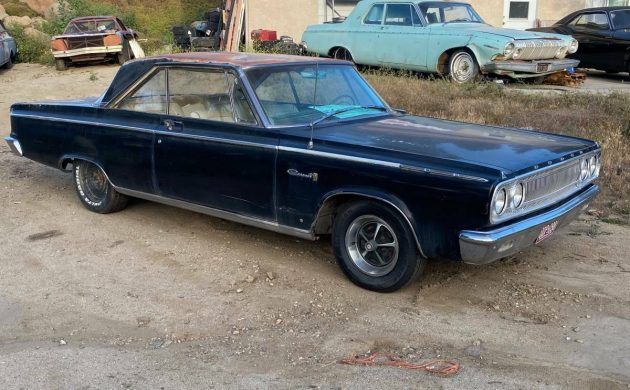
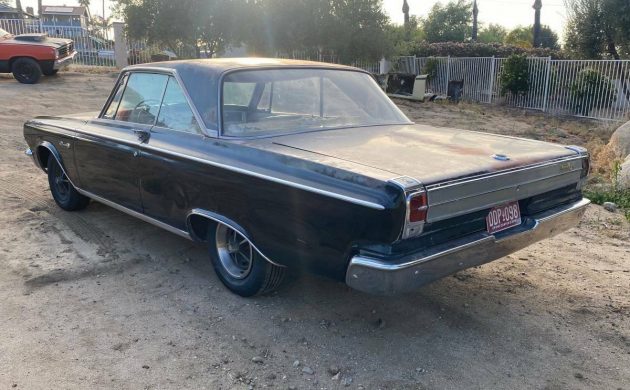
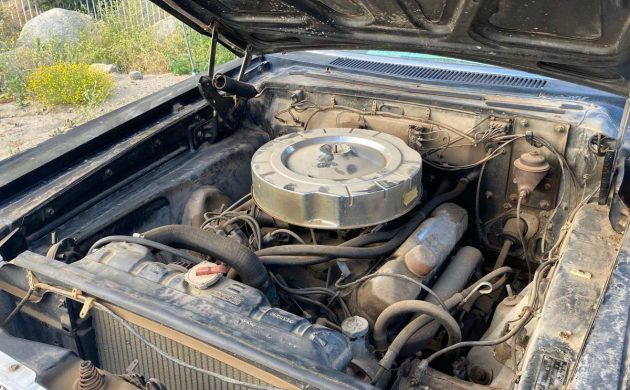
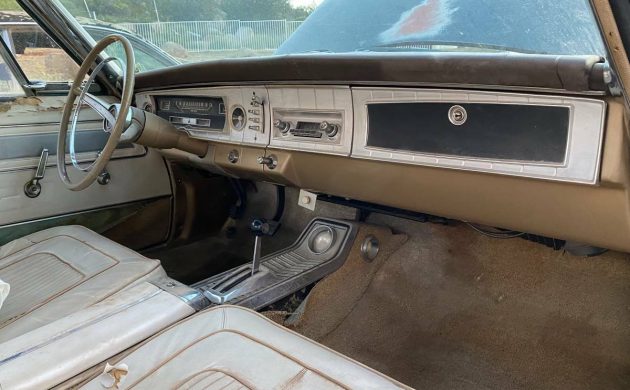
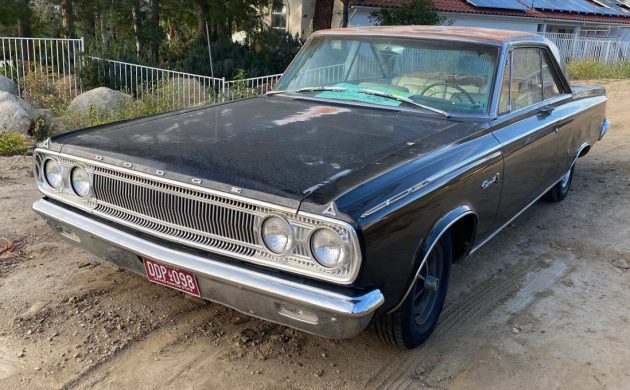


Seems to be a part of a Mopar collection. Looks like a very good car to restore. I wonder if any of the other cars are for sale (the Barracuda, perhaps?) GLWTA!! :-)
Max wedge motors were in production from 62-64 and had the dual carbs on opposite corners.
Yeah, max wedge had 11.1 compression and the dual Carter 4bbl. This is just a baby 440, though a much more street able engine. Max wedge was really just good for the drag strip.
https://en.wikipedia.org/wiki/Max_Wedge
A great year in stying for the Coronet. A nicely optioned numbers matching Mopar. Fix what is needed and drive it. The best asset in a classic muscle car is a good body. This one is limited to just surface rust. Body work can be expensive and this one puts the new owner ahead of the curve.
How come no one has used “Max Wedge” as a Barn Finds moniker yet? Asking for my friends Ike Onick and Pa Tina.
Street wedge not a max.
Who put the label “Max Wedge” on this write up? As another commenter pointed out they only made them from 62 to 64.
Not a MAX wedge. It’s a Street wedge.
The eBay listing makes no mention of the car being a ‘Max Wedge’.
I had two 1965 Dodge Coronets. Both were convertibles. The first was a light blue, blue interior, black top, buckets console 383 V8 with a 727 trans.
My first wife let her mom and dad “borrow” it and, of course, the brake pedal and the gas pedal were “confused” and, needless to say, it exists no more.
The second one was a Coronet 440. Black black top, red interior, bench seat, power top. 318, 727 trans.
Of course the wife let her parents “borrow” this one, too. That one, it turns out, was a long term loan. The water pump went out and, instead of telling me about it so I could fix it, they just kept filling the radiator with plain water, and, being on the southern shore of Lake Ontario in the winter, we all know what happened.
I paid $500 for the 383 blue convertible and $350 for the 318 black convertible.
I’d love to have either one back.
Had a landlord with a 64 Fury Convertible, 426 Max Wedge so I’ve had a chance to see and work on one (a little) firsthand. That one shown is a street wedge and I’m sure a lot more street-able and not as thirsty as a Max Wedge IMO. They will definitely determine how much you love them as you cruise by/into the gas station.
I’m sure it’s potent as it stands but the seller needs to get their facts straight.
My 2 cents.
It does say Street Wedge in the ebay ad.
It’s a street wedge for sure, one carburetor and the close up of the trim tag shows “80” under “AB”. 80 is a 426 street wedge, 70 would be a 383 and 82 is a Hemi.
One question about the motor though, the exhaust manifolds look like the 62-64 Max Wedge manifolds. Of course my eyes aren’t as good as they were 30 or 40 years ago, but I went and looked at the stock manifolds on my 65 Belvedere 383 and they appear to be very different than what’s on this one. If they are Max Wedge manifolds, they’re rare and valuable.
Also, don’t assume that there’s no rust. If it’s ever been wet or exposed to humidity, there will be rust. The inside of the cowl area was unpainted from the factory, it’s prone to rust. Also the inner fenders have a seam that has one piece lapped over the next one and they’re spot welded. It may look decent, but the Mopar expert body man who did my car guaranteed me that it will eventually rust there. Then the windshield wiper mechanism is under the dash and the original seal where it goes through the cowl area to keep water out will eventually leak and water will get in. There is a good aftermarket seal that you can get for a few bucks.
Ask me how I know this stuff . . . . I paid to have it fixed. I know it’s supposed to be a dry weather car, but in 57 years it has to have been wet more than a few times, so be prepared to fix all the Mopar problems you’ll find.
They all rust in the cowls. My 65 Coronet convertible had cowl rust but everything else was good. The coating process was definitely lacking at Chrysler back then. I was told that they just dipped them half way up instead of a complete immersion bath in the anti corrosion solution.
It is a Street Wedge as said before. The Maxi went the way of the dodo when the Hemi came out in 64. A couple of friends of my dad ran SS/A Hemi cars in 64-67 then they went to Top Fuel funnies and dragsters
Gary, They were designed to fail. If you tried to keep one more than four years, it was going to rust unless you kept it in a garage in SoCal or Arizona. That way you saw rust and had to buy another one by 1970.
My body man got a 65 Satellite out of LA in the early 1990’s, and the first thing he did was tear it apart and fix all the weak points that he knew were going to be a problem.
My 65 Belvedere was as clean as anything around Western PA could be, never driven in winter, but when we went to restore it about 20 years ago the local Mopar man/body shop owner explained to me where the failure points are. We fixed them, but it wasn’t cheap. And Chrysler could have avoided them if they wanted to. But the didn’t .
I still love my 65 Belvedere, but I have more money in it than I have in two black over hugger orange 69 Z/28 Camaros. But those were from 7 and 20 years before the Belvedere restoration. You still gott’a love Mopars.
All cars are designed to fail no matter who makes them. Its called planned obsolescence. Cars are appliances , and the companies dont want or expect you to keep them forever, otherwise they’d go out of business. Whenever a rotted old car pops up here you always read comments about what junk they are, but in reality, they weren’t even supposed to be still around